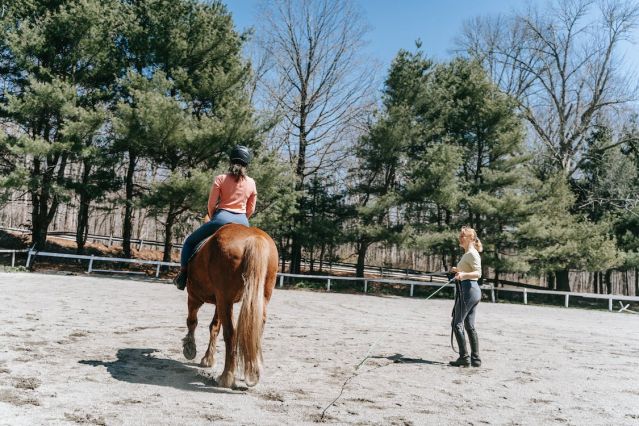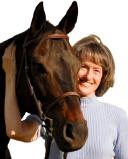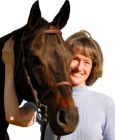Coaching
Coaching in Layers
Thinking about skill, cognitive qualities, and emotional tone while teaching.
Posted February 1, 2024 Reviewed by Hara Estroff Marano
Key points
- Coaches and teachers affect students' skill levels, cognitive understanding, and emotional intelligence.
- No matter what we teach, we need to consider all of these layers.
- The surface maneuver or immediate task is the least important, yet we focus most on it.
- We develop or diminish trust in every teaching/learning interaction, whether instructing humans or animals.

Training horses and riders makes me aware of the many layers in teaching and coaching—layers that everyone recognizes after the fact but which we don’t consider consciously often enough. These layers are part of every teaching and learning process—sports, academics, emotional relationships, general knowledge, and life skills.
At the first and most basic layer, I teach horses specific maneuvers. You might, too, or maybe you teach human athletes a sport or school students in a subject like math or literature. We are all teaching our students to complete some task. Perhaps the task is to solve an algebraic equation, kick a football, comprehend Beowulf, or ride a horse. I teach horses to stand still when they don’t want to, to canter around corners without falling over while carrying riders, or to leap over obstacles that look scary.
We tend to focus most on this primary level. In fact, many coaches and teachers do not think beyond that level at all, at least not consciously. The athlete or student or animal must learn to carry out some physical routine or mental procedure from start to finish. Human learners must be able to assess a task’s quality and know how to apply it to daily life. As expertise builds, the skills become more difficult. It feels as if this basic level is the most complex layer of all. But it’s not.
The second layer in my work—and probably in yours—is to recognize that while teaching a task, we are also teaching others how to learn. Many methods of learning exist: learning by association, observation, reasoning, emotion, testing, consequence, logic, just to name a few. Some of these methods are common to both horses and humans. Plus, there are different modes of learning—visual, kinesthetic, verbal, interpersonal, auditory, solitary, or collaborative.
Whenever we teach someone, we are introducing them to our ways of instruction. These ways might be different from what they have experienced in the past. We might have to change methods of teaching that don’t match a particular student or athlete or animal’s method or modes of learning. But even when our methods and modes remain the same, we underestimate their power at a cognitive level.
Here’s an animal example: Many horses are taught by negative reinforcement. I prefer instead to teach horses by nonedible reward as often as possible. Over time, even a horse comes to understand what sort of treatment she can expect from a given trainer. The horse learns that one trainer strokes her neck when she does the right thing; another smacks her when she does the wrong thing; and a third makes something unpleasant stop when the horse succeeds. Think how much more analytical a human learner will be, anticipating results based on the teaching methods you happen to use most often.
The methods of instruction generalize and transfer, too. A student who has learned by observation, for example, will be more likely to teach his children, animals, and friends by that same technique. Another who learns by cognitive reasoning and explanation will probably teach others in that way. It’s the old story—punishment begets punishment, kindness begets kindness.
At the third level or layer, each time we teach a lesson, we are also either developing or diminishing trust and rapport. We are—or should be—modelling professionalism, kindness, mastery, self-discipline, and a sincere desire to help. Human brains pick this information up whether we are conscious of sending it or not. In my line of work, equine brains pick it up too, sensing whether a horse trainer’s instruction is patient, gentle, and clear or rushed, harsh, and ambiguous.
A horse is a prey animal that survives by being fearful and vigilant, running away at the slightest indication of trouble or risk. It takes years for a human to gain the trust of a horse but only a moment to break it. People who have been victimized in one way or another are similar. They have lost trust in others; they have generalized that loss to people who have not harmed them; and, worse, they have lost the desire to develop trust again. Like prey animals, they want to run at the slightest sign of potential trouble or confusion.
Coaches and teachers who actively think about the emotional lessons they are conveying do a much better job. No one learns well while frightened, angry, or upset—not a horse, and not a human. But even beyond that, teachers and coaches can convey so much more in terms of emotional intelligence. We can build mutual bonds of trust that help our students in all areas of their lives, as well as within the boundaries of the sport or subject we teach.
Coaching requires consideration of the various layers at which we establish rapport with others. If you are a coach, parent, friend, or teacher of any kind, take the responsibilities of the layers seriously. For horseback-riding instructors, it’s not just about a student learning to trot. It’s also about her cognitive development as a person who understands how to learn, and why. It’s about her emotional needs and the way we can safeguard and educate her heart. It's about who this precious individual is and who she will become. The same is true for the horses we train. It’s layers.




